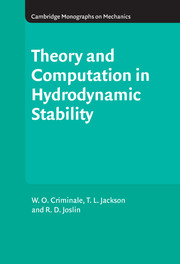Book contents
- Frontmatter
- Contents
- Figures
- Tables
- Preface
- 1 Introduction and problem formulation
- 2 Temporal stability of inviscid incompressible flows
- 3 Temporal stability of viscous incompressible flows
- 4 Spatial stability of incompressible flows
- 5 Stability of compressible flows
- 6 Centrifugal stability
- 7 Geophysical flow
- 8 Transient dynamics
- 9 Nonlinear stability
- 10 Transition and receptivity
- 11 Direct numerical simulation
- 12 Flow control and optimization
- 13 Investigating hydrodynamic instabilities with experiments
- References
- Author index
- General index
13 - Investigating hydrodynamic instabilities with experiments
Published online by Cambridge University Press: 06 July 2010
- Frontmatter
- Contents
- Figures
- Tables
- Preface
- 1 Introduction and problem formulation
- 2 Temporal stability of inviscid incompressible flows
- 3 Temporal stability of viscous incompressible flows
- 4 Spatial stability of incompressible flows
- 5 Stability of compressible flows
- 6 Centrifugal stability
- 7 Geophysical flow
- 8 Transient dynamics
- 9 Nonlinear stability
- 10 Transition and receptivity
- 11 Direct numerical simulation
- 12 Flow control and optimization
- 13 Investigating hydrodynamic instabilities with experiments
- References
- Author index
- General index
Summary
This text has covered some historical and more advanced theoretical and computational techniques to predict the onset of transitional flows with linear methods, the amplification and interaction of these linear modes in the nonlinear regime, and the matching of these predictions with empirical models. Furthermore, some methods of control have been developed and discussed in the chapter on flow control. Here, we address issues associated with investigating hydrodynamic instabilities using experimental techniques. These issues include the experimental facility, model configuration, and instrumentation, all of which impact the understanding of hydrodynamic instabilities.
Because the authors have primary expertise in theory and computation, we readily acknowledge the topics in this chapter are based on literature from leading scientists and engineers in the field of transitional flows. This chapter serves as an introduction to the experimental process. The content of this chapter is primarily based on the review by Saric (1994b) and a text by Smol'yakov & Tkachenko (1983).
Experimental Facility
Because the theoretical and computational modeling of a hydrodynamic instability process is the goal, two key aspects of the flow must be carefully documented in the experiment before studying the instabilities. First, the physical properties of the flow environment must be understood within the experimental facility. The makeup of the facility dictates the background (or freestream) disturbances and the spatial-temporal characteristics of the flow environment.
The incoming freestream environment should be understood and characterized before commencing with a discussion of the use of artificial disturbances, that are typically the manner hydrodynamic instabilities are investigated.
- Type
- Chapter
- Information
- Theory and Computation of Hydrodynamic Stability , pp. 401 - 409Publisher: Cambridge University PressPrint publication year: 2003



